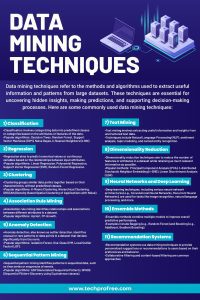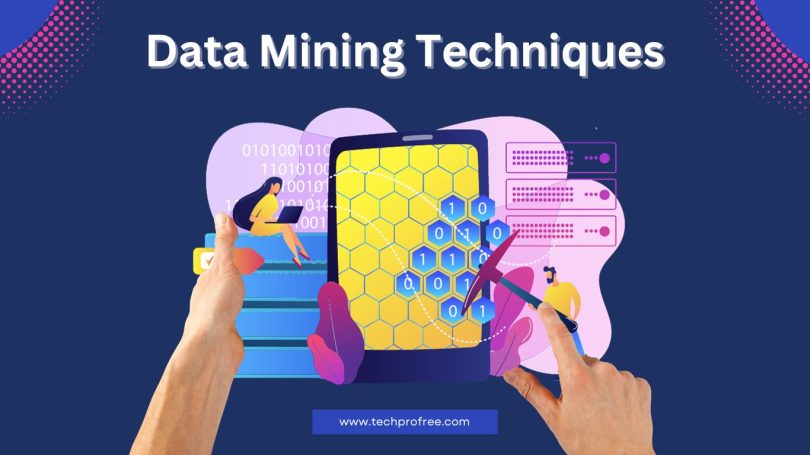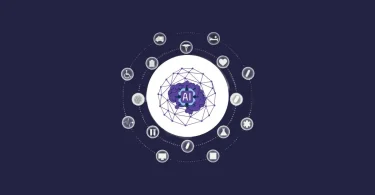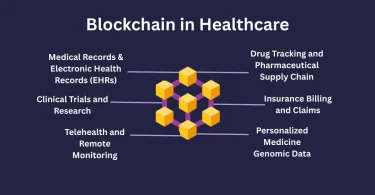Data mining encompasses the extraction of valuable insights from extensive datasets, involving the exploration and identification of meaningful patterns within complex data structures. Ongoing efforts by researchers and practitioners are dedicated to refining methodologies, aiming to optimize the efficiency, cost-effectiveness and precision of this intricate process. Various terms like knowledge mining, knowledge extraction, data or pattern analysis and data dredging are often used interchangeably with data mining.
Data mining finds applications wherever substantial data sets are stored and processed.

Techniques in Data Mining:
Association Analysis:
Association analysis involves identifying rules that show frequent co-occurrence of attribute-value conditions in a given dataset. This method, widely used in market basket analysis, has seen significant research. One approach, called associative classification, generates instructions using a modified version of the Apriori algorithm.
Classification:
Classification entails finding models that describe and differentiate data classes or concepts. Predictive models play a crucial role in classifying objects that lack identifiable labels. Various classifier types are utilized in this context, encompassing decision trees, Support Vector Machines (SVM), Generalized Linear Models and etc.
- Decision Trees: Decision trees, resembling flowcharts, use nodes to represent attribute tests, branches for test outcomes and leaves for classes or class distributions. These trees can be transformed into nonparametric classification rules, making them interpretable and accurate, especially for simpler datasets.
Prediction:
Prediction is akin to classification but involves foreseeing the value or value ranges of an ordered attribute. Indeed, these models are developed specifically to determine the class of an unlabeled object or estimate the likely values of a particular attribute.
Clustering:
Clustering group data objects without using predetermined class labels. It aims to maximize intra-class similarity and minimize interclass similarity. Clusters created in this way can be seen as classes of objects, enabling rule inference and facilitating the formation of hierarchies of similar events.
Regression:
Regression is a statistical methodology, that utilizes pre-existing data to anticipate continuous values for unfamiliar observations. It is employed to forecast continuous values and includes models like linear and multiple linear regression.
Artificial Neural Network (ANN) Classifier Method:
A computational model called an artificial neural network (ANN), often denoted as a Neural Network (NN), draws inspiration from biological neural networks. This system comprises interconnected artificial neurons, where individual connections are assigned specific weights. During the learning phase, these weights are adjusted systematically, enabling the network to predict the correct class label for given input samples. Neural network learning, also known as connectionist learning, involves adjusting these connections. Neural networks, though having longer training times, find application in scenarios where time is not a constraint. Determining parameters like network structure empirically, such as its topology, can be challenging. One drawback of neural networks is their poor interpretability, making them less favorable in early data mining scenarios.
Outlier Detection:
Outliers are data objects in a database that deviate significantly from the general behavior or model of the data. Detecting these outliers is known as outlier mining. Statistical tests, distance measures, and deviation-based techniques are used to identify outliers. Deviation-based methods, in particular, analyze differences in the primary attributes of items within a group to identify exceptions.
Genetic Algorithm:
These are adaptive heuristic search methods situated within the wider domain of evolutionary algorithms. Grounded in the principles of natural selection and genetics, these algorithms replicate biological processes to enhance solutions and achieve optimal outcomes. They employ random search and historical data to guide the search toward better-performing regions in the solution space. Genetic algorithms are widely used for optimization and search problems. It emulates the natural selection process, reflecting how adaptable species survive environmental changes, reproduce, and pass their traits to future generations. These individuals are encoded as strings of characters, integers, floats, or bits, similar to chromosomes, enabling the algorithm to explore and optimize solutions iteratively.
Conclusion:
In a nutshell, the techniques of data mining stand as essential tools for unraveling complex patterns within extensive datasets and finding applications across diverse fields. The process involves extracting valuable knowledge from large and intricate datasets, identifying significant trends, making predictions, and revealing novel insights. These methodologies play a pivotal role in enhancing decision-making processes in various sectors, including business, science and engineering. By enhancing efficiency and accuracy, data mining emerges as a potent instrument, capable of addressing a myriad of challenges. Ultimately, it has the transformative potential to revolutionize problem-solving approaches, facilitating improved decisions and a deeper comprehension of the intricate world we navigate.




Leave a Comment